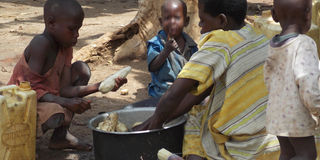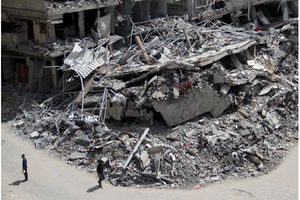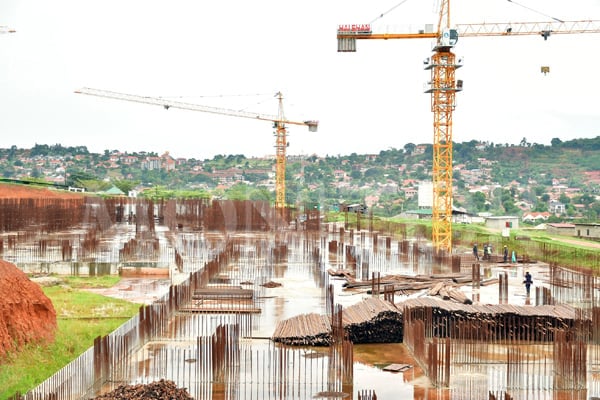Prime
The role of judges in alleged adoption scams

A woman prepares a meal in rural Uganda. Some of the children who have been adopted are from needy families. Photo/FILE
What you need to know:
In 2020, the US imposed sanctions on two Ugandan judges, a lawyer and her husband for their alleged involvement in activities that victimised young children in a corrupt adoption scheme. Retired judge Moses Mukiibi writes on the role of judges.
I do not think that I can scrap enough to remove the wrong impression that removal of children from their parents was a conspiracy between lawyers and judges. I feel I must make a few things clear for the present and posterity.
We live in a world where corruption has engulfed many sectors. So even without the slightest knowledge of how a process worked, one is quick to think it was because of money.
One of the reasons for this is a failure to understand the difference between the person carrying out the duties of a judge and the High Court.
The High Court of Uganda is an institution. A person appointed to serve at that level carries out the functions of the High Court. Such person, however filthy, cannot do what the High Court is not empowered to do.
Clause (1) of Article 139 of the Constitution provides that the High Court has unlimited jurisdiction in all matters. This is reiterated in sub-Section (1) of Section 14 of the Judicature Act. In entertaining applications for legal guardianship, the High Court invoked the provisions of Section 14 of the Judicature Act. So the High Court exercised powers conferred on it by law. It was not a clandestine arrangement between an advocate and an individual judge.
Following the requirements of the legal provisions and guidelines I had developed a check list of things to look for in an application. My check list covered a few pages. I had to examine the filed documents to see whether each requirement was covered.
Making submissions
After hearing the evidence an advocate would make submissions. An attempt would be made to show that all the requirements of the law had been covered. If nothing else was required to be filed in court, submissions would be closed and a date given for delivering a ruling.
A judge would be left to study all the documents filed in support of the application. He/she would refer to the law and all precedents cited or produced in court. He/she would apply the law to the evidence, consider all the circumstances of the application, make findings, give reasons for any conclusion, and render a decision.
Often a judge would reiterate the principle [now a provision in the Children Act] that in all matters concerning children the paramount consideration is the best interest and welfare of the child.
I wrote a pamphlet on:
(i) The abandoned child.
(ii) The supremacy of the child welfare principle.
It contained court case reviews and analysis. I examined the Children Act (before the 2016 amendments). I considered the criteria used by courts to take decisions concerning children. The children’s rights are set out. I examined a parent’s right to have custody of a child and its corresponding duties. I discussed what amounts to acting in the best interests of a child. I referred to cases which defined the term “welfare”. I discussed the duty of court or other authority to do what is in the best interest and for the welfare of a child vis a vis a requirement to strictly apply and observe the statutory provisions in the Children Act.
I considered the strict provisions in Section 46(1) of the Children Act. I, through case reviews, gave instances where because of a commitment to do what is in the best interest of a child the Court had allowed the child welfare principle to override the statutory provisions in Section 46(1) of the Children Act.
The court consistently, through pro-activism, expanded the application of the child welfare principle and demonstrated its supremacy or paramountcy as a consideration. The court developed legal juris prudence in this area.
Was this appreciated? At least not by the ministry of Gender. To them this was corruption and they set out to fight it.
Surprisingly, the amended law has now expressly provided for a waiver by court on other authority of the strict requirements specified in sub-Section (1) of Section 46 of the Children Act in exceptional circumstances.
So sometimes the term “corruption” is adopted by those who fail or do not bother to understand how the experts enjoy delving in the creation of jurisprudence. Ministry of Gender staff called it all sorts of ugly names. Fortunately, some of them have been drawn nearer to the manufacturing plant. Maybe they will understand better the chemical mixtures/combinations.
When court eventually delivered a ruling it was not a private matter. A ruling had to be typed/printed, signed and kept on court record. It was circulated on network for anybody interested to read and use as reference. Did this remove the poison from some people’s minds? Unfortunately, no. It was still corruption.
What was the origin of the children who were handled?
Sub-Section (I) of Section 46 of the Children Act (before the 2016 amendments) on Inter-Country adoption provided that a person who was not a citizen of Uganda could, in exceptional circumstances, adopt a Ugandan child. Adoption was not restricted to orphans.
The court could entertain petitions for adoption and applications for legal guardianship in respect of children who had both parents, or at least one known parent.
Other types of children were dealt with for example:
(1) Children born as a result of rape or incest.
(2) Children picked from lunatics or persons with unsound mind (and fathers unknown).
(3) Children abandoned in hospitals, rubbish heaps, at the gates of Churches.
(4) Children rescued from pit latrines.
(5) Children deliberately mistreated by their caretakers, say by starving them.
(6) Children born with handicaps – physical or mental.
(7) Other vulnerable and needy children.

Retired judge Moses Mukiibi
The judges of the Family Division of the High Court were at the forefront of efforts aimed at streamlining the process of petitioning for adoption or applying for legal guardianship orders.
Judges often attended stakeholders meetings who included staff and officials from the ministry of Gender. The purpose of such meetings was to discuss guidelines for the better implementation of the provisions of the Children Act.
I wrote another pamphlet: Legal Guardianship Outside Uganda.
A dilemma for courts
The prospect of a needy child enjoying benefits but with no assurance of protection. I shared this with –
(i) Every person who applied for a child.
(ii) Staff from ministry of Gender, probation and social welfare officers.
(iii) Embassy staff.
(iv) Top management of the Judiciary.
(v) Advocates.
(vi) Police officers.
Despite all these efforts, some senior officials of the ministry of Gender tried to show that there was a state of lawlessness [corruption] in the management of adoptions and legal guardianship matters. They opted for the path of the blame game against advocates. In some instances they locked horns.
The judges, like other stakeholders, were conscious of the possible risks that the children could face after being adopted or being placed under legal guardianship of foreigners.
A reading of Sections 44, 45, 46 and 47 of the Children Act (as it then was) showed that the final decision as to whether or not a child could be adopted by a person who was not a citizen of Uganda had to be taken by a judge of the High Court.
This did not please senior staff in the ministry of Gender. It was corruption on the part of the High Court. So, they invented another layer in the structure of a vetting committee (to remove the corruption).
Would the High Court then be left with the function of “rubber stamping”?
There were other parties who played roles before and after the decisions of the High Court. For example:-
(i) Probation and social welfare officers who submitted reports on children to assist court.
(ii) Interpol – who had to establish whether the applicant did not have a criminal record.
(iii) Ministry of Internal Affairs which issued a passport to the child for it to be taken out of the country.
(iv) The embassies: they used to be very strict when considering applications for visas in respect of children who had been placed under legal guardianship or adopted. Some embassies carried out their independent investigations for verification of information.
So, the process leading to the placement of a child under legal guardianship or adoption involved all the above and other parties. Were they all participants in a scam?
It may be suggested that the US government organise meetings between Uganda government with American adoptive parents, together with the children they took, in the various states. The Ugandan officials would assess the condition of those children.
American adoptive parents used to file half yearly or annual reports (with pictures) showing the progress of the child. The Deputy Registrar, Family Division and the probation officers used to receive such reports.
The question remains: Did an individual judge do what the law and practice required the High Court to do?
Authored by Moses Mukiibi,a retired judge




